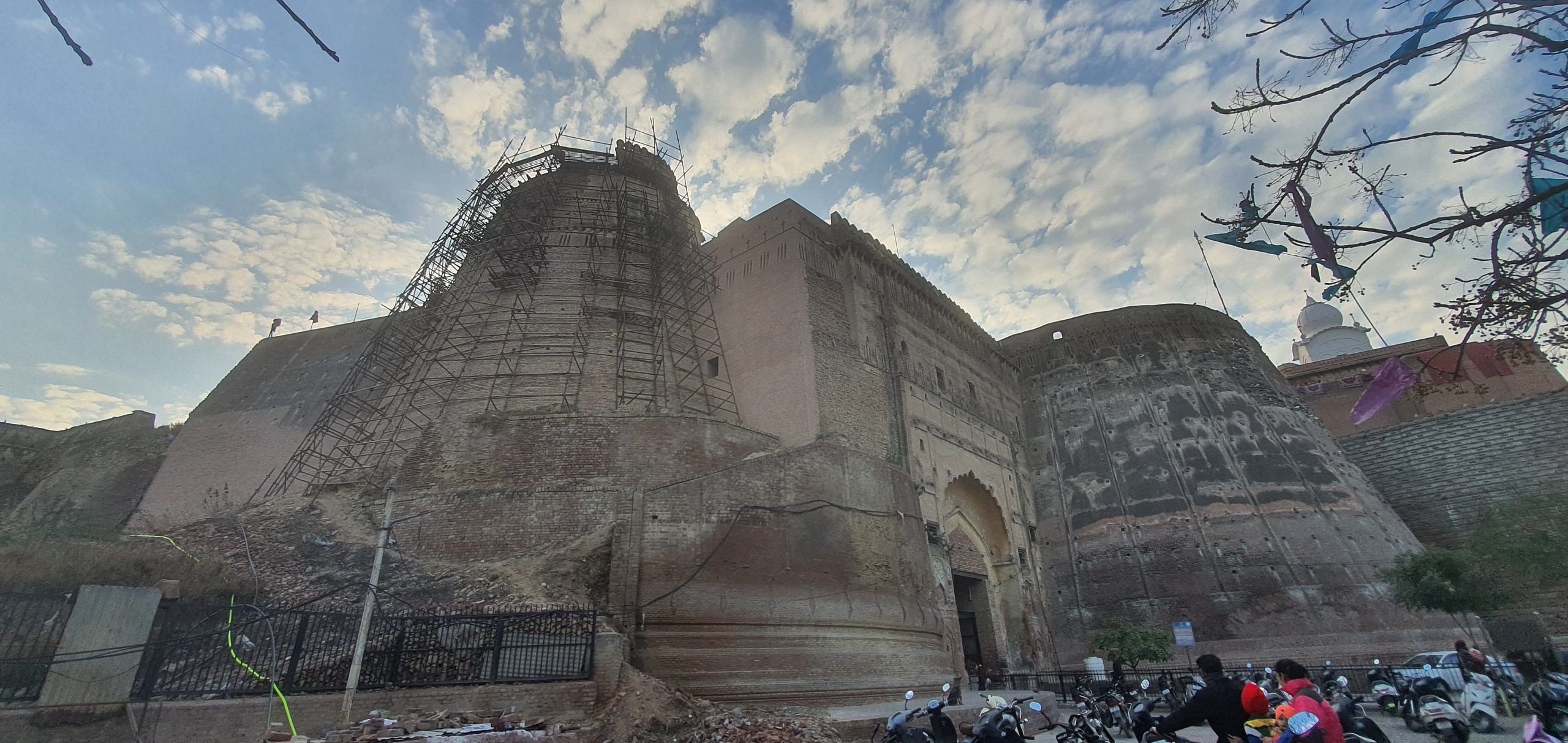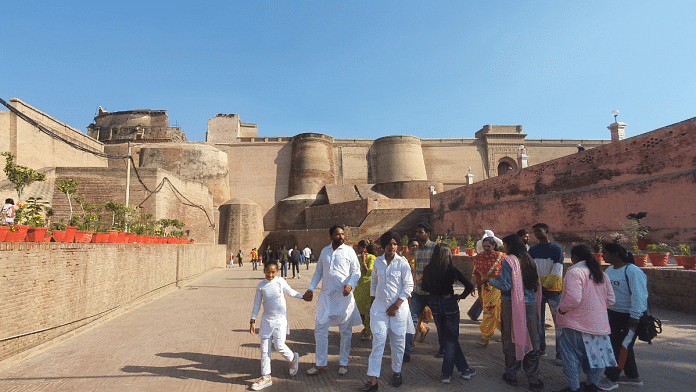Bathinda/Punjab: Bathinda Fort is buzzing with activity. As thousands of visitors continue to flock to the site every day, a specialised team of 30 to 40 people from the Archaelogical Survey of India, has finally started repairing damaged portions and strengthening fragile sections of what is considered to be India’s oldest surviving fort.
Also called Quila Mubarak, this quiet, pristine fort has withstood the vagaries of conquerors for at least 1,600 years. The sprawling 15 acres it occupies is a sharp contrast to the serpentine lanes of the crowded Bathinda bazaar that lead to it. More than 100 feet high, it stands tall and proud in the heart of Punjab.
However, maintaining the Bathinda Fort is a challenge.
The fort was built with clay bricks. Over the last few years, several bastions of the fort have collapsed. With no repairs for two years due to the Covid pandemic, its condition has deteriorated further. According to ASI officials, one of the main bastions of the fort partially fell apart in 2022.
The steady influx of visitors throughout the year is also a challenge. On average, the Bathinda Fort gets more than 4,000 to 5,000 visitors every day, and the number touches 10,000 on weekends. It also houses the Gurdwara Qila Mubarak, which was built in the early 19th century to mark the visit of Guru Gobind Singh, the last Sikh Guru, a century earlier. On Gurupurab and other sacred days, footfall even goes up to one lakh a day.
No tickets need to be bought to see the Quila Mubarak, and unlike most other historical sites, it’s open to visitors till 9 pm. For the religious, the prominent gurdwara is the draw.
“For the history buff and tourists, it [Bathinda Fort] links ancient India to medieval India, and for the hundreds of residents of Bathinda, it’s that quiet, serene place everyone flocks to at the end of their day,” says Gurdeep Singh of ASI, caretaker of the fort.
And for store owners in the narrow streets around the fort, it is a source of income.
“The bazaar benefits from it. When we were small children, our parents would bring us to the fort routinely on Sundays,” says Vijay Goel, a toy shop owner at Bathinda bazaar.
Stories such as Delhi Sultanate’s first woman ruler Razia Sultan being imprisoned in the Qila Mubarak and Prithviraj Chauhan wresting control of the fort from Muhammad Ghori add to its allure.
Also read: Why are we digging Rakhigarhi a 9th time? This Harappan site is a gift…
Witness to ancient to medieval history
The bastion that broke down last year housed the Rani Mahal—a single room where Razia Sultan was held captive. It’s currently closed to the public, and repairs have started. The team is using thin tile bricks and joining them with a mixture of lime and mortar as cement is not used in the conservation of such structures.

Unlike other forts in India, the Bathinda Fort, believed to have been built by Raja Dab (90-110 AD), has a very simple layout that points to its antiquity. It stands on elevated ground, not on a hilltop, with 32 small and four large bastions at its four corners.
“There is only one entrance to the fort on the eastern face. The gateway is a three-storey structure showing Mughal features. The massive doors are spiked. They are flanked on either side by two of the major bastions. At the top of one of these bastions is the Rani Mahal,” says Singh.
The fort is also listed as a Monument of National Importance by the ASI. “According to the ASI records, the fort may have been built around the 6th century AD as a defence against the invading Hunas,” says Sri Om who oversees the maintenance of the fort as the ASI’s conservator in Bathinda.
There’s more medieval history on the Bathinda Fort. “Bathinda was the Shahi king Jayapala’s capital. Mahmud of Ghazni captured this fort in the 11th century AD after King Jayapala was defeated and burnt himself on a pyre,” he adds.
The fort played a central role during this tumultuous period. Muhammad Ghori stormed its bastions in 1191 AD. “Bathinda was then ‘Tabarhinda’. Although some historians debate [about] Tabarhinda being either Bathinda or Sirhind, most agree that the Tabarhinda referred to in medieval texts is Bathinda,” says Sri Om. Ghori’s move forced Prithviraj Chauhan to rush to Tabarhinda and wrest the fort back in the famous First Battle of Tarain.
More than a century later, in 1240 AD, Malik Ikhtiyar-ud-din Altunia, the governor of Bathinda under the Delhi Sultanate, imprisoned Razia Sultan in Qila Mubarak. Her lover Yakut was dead. But in this fortress prison, the childhood friendship of Razia Sultan and Altunia blossomed again. The two reconciled, raised an army, and raised a rebellion against the nobility but failed.
The Bathinda Fort was also one of the most strategically located defence structures between Multan and Delhi. “Later, during the Mughal period, this fort was an important route to Lahore,” Sri Om adds.
Also read: Purana Qila is being dug up again. ASI wants new excavations to be ready…
A fort for respite
The Bathinda Fort has a main hall, attached side rooms, and balconies. There are very few rooms, says Gurdeep Singh. “It can be said with certainty that this fort was not designed to hold a large population unlike other forts. It could have been used to temporarily give reprieve to travelling or warring armies,” he adds.
Situated on top of another raised structure to the right of the gateway is the Gurdwara Qila Mubarak, built by Maharaja Karam Singh of Patiala.
“Some of that portion needed repairs, so the Guru Granth Sahib was shifted to a raised platform in front of the gateway inside the fort. This raised platform was probably originally a muster and parade area,” Singh adds.
Since the raised platform space is more open, the Shiromani Gurdwara Parbandhak Committee (SGPC), which manages the gurdwara continued to have the Guru Granth Sahib on the raised platform instead of shifting it back to the original spot. “Visitors pay obeisance both at the original spot and the place where the Guru Granth Sahib has been housed,” says Singh.
There’s an interesting story behind Guru Gobind’s visit to the fort. It is said that the people of Bathinda asked the Guru to visit it. They believed that a monstrous creature destroyed the houses in the surrounding village and lived inside the fort. Guru Gobind Singh communicated with the creature, asking him what he wanted. The latter told the Guru that he had been starving for long and that if somebody fed him, he would leave the fort forever. The Guru then asked for a bull to be brought from the nearby village Nat Banger. After eating what the Guru offered, the creature left the fort and the village in peace.
“We have been told that whatever we ask for in this gurdwara is fulfilled by Guru Sahib. I have come here with my family to thank Guru Sahib for treating my mother,” says Balwinder Singh of village Bajoana in Bathinda.
Under the weight of time
The fragility of the structure on which repairs are currently underway is posing a huge challenge to the conservators. The ASI staff says it slows down the work.
The walls are patched with at least seven different kinds of bricks, bearing testimony to the different periods of India’s history. Each conqueror subsequently left a mark on the structure.
“Since mud bricks don’t last long, they were replaced by the smaller nanak shahi bricks at some places and also burnt bricks at other places,” says Sri Om.
(Edited by Humra Laeeq)



